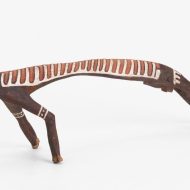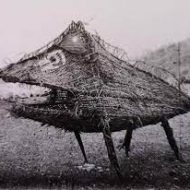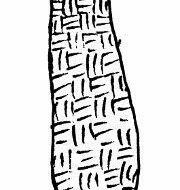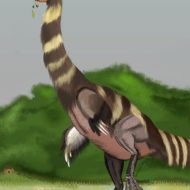Kaiamunu : The Wicker Demon
Listen
At a glance
| Description | |
|---|---|
| Origin | Papuan Mythology |
| Classification | Hybrids |
| Family Members | N/A |
| Region | Papua New Guniea |
| Associated With | Coming of Age, Therizinosaurus, |
Kaiamunu
Introduction
Kaiamunu is a prominent figure in Papuan mythology, revered for supernatural abilities and a deep connection to the natural world. In Papua New Guinea, rich with towering mountains, lush rainforests, and vibrant cultures, myths and legends weave a complex tapestry. Kaiamunu is central to this folklore, with two distinct interpretations: one portrays Kaiamunu as a mysterious creature resembling a dinosaur, believed to be a descendant of the raptor family; the other depicts Kaiamunu as a demon associated with initiation rituals in the Purari Delta. This hybrid creature embodies the spiritual essence and cultural heritage of the Papuan people, illustrating the diverse interpretations across different regions.
Physical Traits
Kaiamunu, a figure of myth in Papua, is portrayed in two distinct forms depending on the region and story. In the Purari Delta, Kaiamunu appears as a monstrous wicker structure resembling a large basket with four legs. This terrifying entity measures between 9 to 12 feet in length, featuring a long neck and a powerful roar likened to thunder. It’s described as a reptilian monster with smooth brown skin, a turtle-like head, and notable front claws similar to the Therizinosaurus.
Conversely, in other versions found further north, Kaiamunu is depicted as a colossal creature spanning 10 to 15 meters. Its appearance blends characteristics of a wallaby and a turtle, with a towering head reaching the height of a house and an underbelly as tall as an adult. This form is associated with initiation rituals symbolizing the transition to adulthood.
Physical Traits
Kaiamunu, a figure from Papuan mythology, embodies a unique blend of celestial and terrestrial influences. He is often depicted as the offspring of a divine union between the sky god and earth goddess, symbolizing harmony between these realms. Kaiamunu’s lineage intertwines with spirits of the land, sea, and sky, creating a complex mythological tapestry. Despite his solitary nature and portrayal as either a wilderness predator or a haunting spirit in specific locales, some interpretations hint at a possible connection to ancient reptiles, particularly in regions where he is depicted with reptilian features. The mystery surrounding Kaiamunu’s lineage invites further exploration and interpretation, solidifying his role as a bridge between the natural and supernatural worlds in Papuan mythology.
Other Names
The creature known as Kaiamunu is recognized by multiple names across Papua New Guinea, reflecting the diverse linguistic and cultural landscape of the region. Variations such as Kaiaimunu, Akayamu, Kaimarau, Kailigi, and Kairiwi are used in different communities and oral traditions to refer to this enigmatic figure. These names not only signify regional differences but also emphasize the richness and complexity of Papuan mythology, where Kaiamunu’s identity and significance vary based on local interpretations and storytelling traditions.
Powers and Abilities
The powers attributed to Kaiamunu vary greatly depending on the version of the myth. In the Purari Delta, the wicker demon form is central to initiation rituals, where it symbolically swallows young men during ceremonies, cleansing and transforming them into reborn warriors upon being spit out. This ritual underscores Kaiamunu’s role as a symbol of passage and metamorphosis within specific cultural contexts.
Conversely, in the reptilian version, Kaiamunu is depicted as a bloodthirsty predator that willingly attacks humans and other living creatures, with encountering it seen as a harbinger of certain death. Known for its climbing and swimming prowess, this version portrays Kaiamunu as a formidable and dangerous entity in the natural world.
Across both versions, Kaiamunu’s mythological significance transcends mortal understanding, encompassing powers to communicate with animals, command natural forces, and traverse between physical and spiritual realms effortlessly. These abilities are believed to safeguard the wellbeing of his people through ancient rituals, herbal knowledge, and sacred chants, highlighting his pivotal role in Papuan mythology.
Modern Day Influence
Despite the waning influence of traditional beliefs under modern pressures, Kaiamunu remains a significant figure in Papuan culture.
Art and Storytelling: Kaiamunu continues to inspire Papuan artists, who depict both the wicker demon and reptilian beast in woodcarvings that reflect its enduring presence in local traditions. Stories of Kaiamunu persist through generations, blending with contemporary narratives.
Cryptozoology: The reptilian portrayal of Kaiamunu intrigues cryptozoologists, who explore legends of this creature akin to dinosaur sightings reported in the region. Speculation about its potential existence adds to its mystique.
Tourism: The allure of Kaiamunu attracts tourists eager to delve into Papuan mythology. Local guides incorporate tales of the creature into tours, enhancing the region’s appeal with its rich folklore.
In modern Papua, Kaiamunu’s legacy remains a cultural cornerstone and source of spiritual inspiration. Its mythical tales resonate within indigenous communities, fostering a deeper connection to their heritage and environmental stewardship. Through arts, storytelling, and tourism, Kaiamunu’s enduring influence continues to bridge ancient traditions with contemporary interpretations, ensuring its relevance across generations. Reported sightings of Kaiamunu persist, akin to other cryptids like the Ninki Nanka and Loch Ness Monster, reinforcing its enduring place in Papuan culture.
Related Images
Frequently Asked Questions
What is Kaiamunu?
Kaiamunu is a mythical creature prominent in Papuan folklore, known for its varied interpretations ranging from a wicker demon to a reptilian beast. It embodies spiritual significance and is often associated with initiation rituals and as a symbol of transformation.
What are the different versions of Kaiamunu?
Wicker Demon: Found in the Purari Delta, depicted as a large wicker structure with legs, associated with initiation rites where it symbolically swallows and regurgitates initiates.
Reptilian Beast: Another interpretation portrays Kaiamunu as a dangerous predator resembling a dinosaur, feared for its ability to climb rocks and swim skillfully.
What is the cultural significance of Kaiamunu?
Kaiamunu serves as a cultural touchstone in Papuan society, inspiring art, storytelling, and rituals that connect communities with their spiritual and historical roots. It symbolizes passage and transformation in rites of passage and continues to be a source of cultural pride and identity.
Are there sightings or evidence of Kaiamunu's existence?
Sightings of Kaiamunu are reported periodically, similar to other legendary creatures like the Loch Ness Monster. These accounts contribute to the ongoing intrigue and speculation about the creature’s possible existence.
How does Kaiamunu impact tourism in Papua New Guinea?
Kaiamunu’s mystique attracts tourists interested in exploring Papuan myths and legends. Local guides often incorporate stories of Kaiamunu into tours, adding an element of adventure and cultural immersion for visitors.







